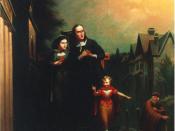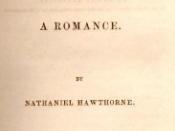The Scarlet Letter is a classic American novel of sin and punishment. It was written by Nathaniel Hawthorne in 1840 and was his first great work. Hawthorne was one of the three primary transcendental pessimists. He disagreed with transcendental optimists on theological reasons. His works often defend and attack the beliefs of the Puritans. In The Scarlet Letter, he presents the chronicle of a woman in a Puritan town who is branded and punished for her sin. Hawthorne uses this book to state that with sin comes consequences and guilt, but the guilt can be erased with repentance without pride.
The book begins as the narrator, presumably Hawthorne, makes a discovery. This discovery occurs at the Custom House while the narrator is working there. The Custom House was a place where the taxes were collected and records were kept. While looking through these records a crimson piece of cloth with a golden "A" embroidered on it is found along with a fool's cap and manuscripts relating the events that had taken place in this town.
The Custom House is a necessary part of this book. It provides a great introduction to the story. It gives the reader a small amount of background of the town of Salem and of the Puritans. This also allows Hawthorne to present his real views on everything through the eyes of an impartial person. It also adds a little bit of ambiguity, one of Hawthorne's main writing characteristics, to the story.
Ambiguity is a double or inconclusive meaning in the story. It is a powerful literary device and is useful to Romanticists. It allows the readers to achieve their own conclusions in a story, stressing the individual. In the "Custom House," ambiguity is useful to the story because one does not know if the...


